
Maryborough Central State School is a heritage-listed state school at 471 Kent Street, Maryborough, Fraser Coast Region, Queensland, Australia. It was built from 1875 to 1953. It is also known as Central State School for Boys, Central State School for Girls, and Central State School for Infants. It was the first state school in Maryborough and was established with separate girls and boys departments. It is the oldest public school in Queensland. It was added to the Queensland Heritage Register on 31 October 1994.
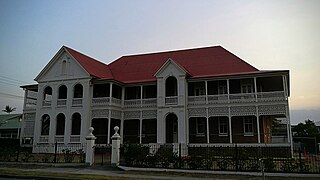
Mount Carmel Convent is a heritage-listed former Roman Catholic convent at 199 Bay Terrace, Wynnum, City of Brisbane, Queensland, Australia. It was designed by Hall & Dods and built in 1915 by William Richard Juster. It was added to the Queensland Heritage Register on 27 August 1999.

St Brigid's Convent is a heritage-listed Roman Catholic convent at 9-17 Upper Clifton Terrace, Red Hill, City of Brisbane, Queensland, Australia. It was designed by Eaton & Bates and built from 1902 to 1923. It is also known as Convent of the Annuciation and Red Hill Convent. It was added to the Queensland Heritage Register on 28 March 2003.
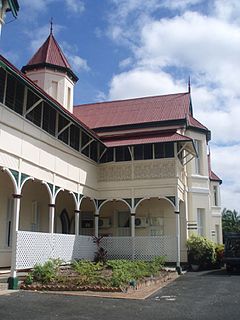
Rockhampton Girls Grammar School is a heritage-listed private school at 155 Agnes Street, The Range, Rockhampton, Rockhampton Region, Queensland, Australia. It was designed by Edwin Morton Hockings and built in 1890 by Moir Cousins and Co. It was added to the Queensland Heritage Register on 20 October 2000.
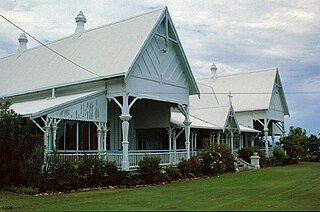
Bishop's Lodge is a heritage-listed house at 13 St James Drive, Belgian Gardens, City of Townsville, Queensland, Australia. It was designed by Tunbridge & Tunbridge and built in 1897. It was added to the Queensland Heritage Register on 21 October 1992.

Townsville School of Arts is a heritage-listed former school of arts and now community cultural centre at Stanley Street, Townsville CBD, City of Townsville, Queensland, Australia. It was designed by Eyre & Munro and built in 1891 by James Smith. It is also known as Dancenorth Theatre and Townsville Arts Centre. It was added to the Queensland Heritage Register on 21 October 1992.
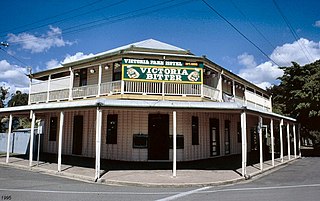
Victoria Park Hotel was a heritage-listed hotel at 266 Boundary Street, South Townsville, City of Townsville, Queensland, Australia. It was designed by Tunbridge & Tunbridge and built from 1895 to 1896 by Jeremiah Dempsey. It was added to the Queensland Heritage Register on 21 October 1992. It was completely destroyed by fire on 8 June 2018.
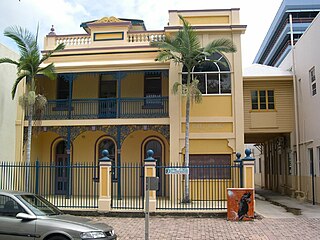
Osler House is a heritage-listed detached house at 35 Sturt Street, Townsville CBD, City of Townsville, Queensland, Australia. It was designed by W G Smith & Sons and built from 1888 to 1950s. It was added to the Queensland Heritage Register on 21 October 1992.

Queensland National Bank is a heritage-listed former bank at 295-303 Flinders Street, Townsville CBD, City of Townsville, Queensland, Australia. It was designed by Francis Drummond Greville Stanley and built from 1878-1879 by C A Ward. It was added to the Queensland Heritage Register on 28 January 1994.

St Mary's Church & Convent are heritage-listed Roman Catholic church buildings at 34 Ingham Road, West End, City of Townsville, Queensland, Australia. It was designed by the Rooney Brothers and built by Cowell & Holt in 1888. It was added to the Queensland Heritage Register on 2 January 1993.

Wolverton is a heritage-listed detached house at 95 Stagpole Street, West End, City of Townsville, Queensland, Australia. It was built c. 1903. It was added to the Queensland Heritage Register on 21 October 1992.

Drystone Wall is a heritage-listed drystone wall at 2-4 Cleveland Terrace, Townsville CBD, City of Townsville, Queensland, Australia. It was built in 1877. It is also known as Queensland Transport, Townsville Library and School of Arts/Licence Testing Centre, and Townsville Supreme Court. It was added to the Queensland Heritage Register on 7 February 2005.

Yongala Lodge is a heritage-listed detached house at 11 Fryer Street, North Ward, City of Townsville, Queensland, Australia. It was designed by Rooney Brothers and was built by the Rooney Brothers from c. 1883 to 1930s. It is also known as Lister Private Hospital, Matthew Rooney's Residence, and Nestle Private Hospital. It was added to the Queensland Heritage Register on 21 August 1992.

St Patrick's Convent is a heritage-listed convent at 45 The Strand, North Ward, City of Townsville, Queensland, Australia. It was built in c. 1883. It was added to the Queensland Heritage Register on 3 February 2012.
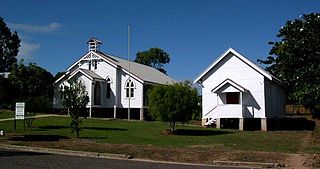
St John's Anglican Church Precinct is a heritage-listed churchyard at 30-34 Macrossan Street, South Townsville, City of Townsville, Queensland, Australia. It was built from c. 1907 to c. 1911. It was added to the Queensland Heritage Register on 21 October 1992.
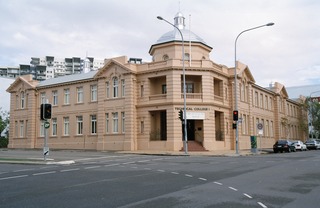
Block A of Townsville Technical College is a heritage-listed technical college building at 212-260 Stanley Street, Townsville CBD, City of Townsville, Queensland, Australia. It was designed by Department of Public Works (Queensland) and built from 1920 to 1921. It is also known as Townsville State High School and the City Campus of the Barrier Reef Institute of TAFE. It was added to the Queensland Heritage Register on 13 May 2004.

Cluden Racecourse is a heritage-listed racecourse at 1 Racecourse Road, Cluden, City of Townsville, Queensland, Australia. It was designed by Walter Howard Tunbridge and built in 1896 by Mr Reid. It was added to the Queensland Heritage Register on 21 October 1992.
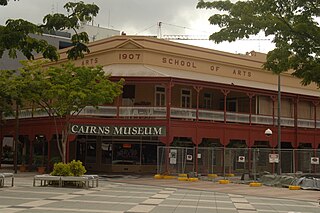
Cairns School of Arts is a heritage-listed former school of arts and now the Cairns Museum at 93-105 Lake Street, Cairns City, Cairns, Cairns Region, Queensland, Australia. It was designed by Tunbridge, Tunbridge & Lynch and built from 1907 to 1941 by Hanson & Sons. It was added to the Queensland Heritage Register on 21 October 1992.

James Cook Historical Museum is a heritage-listed former convent and school and now museum at Furneaux Street, Cooktown, Shire of Cook, Queensland, Australia. It was designed by Francis Drummond Greville Stanley and built from 1888 to 1889 Hobbs & Carter. It was formerly known as St Mary's Convent and School. It was added to the Queensland Heritage Register on 21 October 1992.

Ipswich Girls' Grammar School Buildings is a heritage-listed group of private school buildings at Ipswich Girls' Grammar School, 82 Chermside Road, Ipswich, City of Ipswich, Queensland, Australia. They were built from 1891 to 1968. They were added to the Queensland Heritage Register on 21 October 1992.























